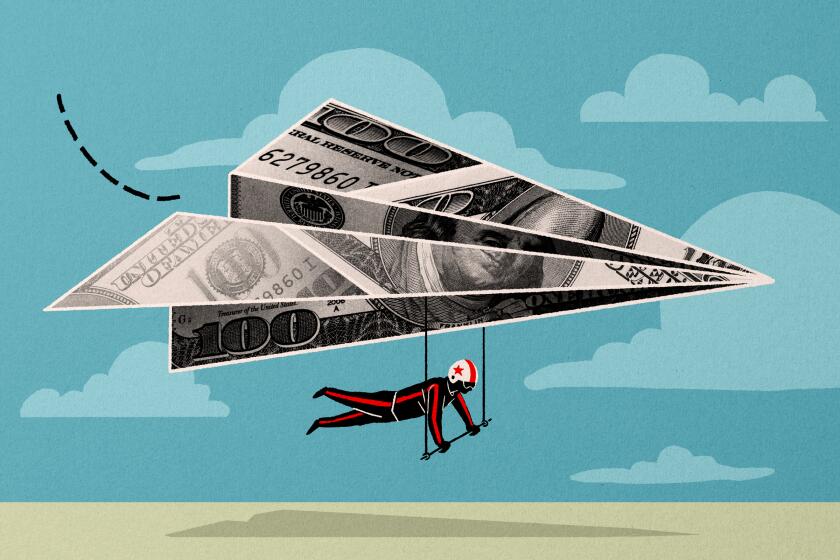Here’s how to budget your money using the 50/30/20 rule

- Share via
Dear Liz: What is the formula now for expenses? When growing up, we were told that one-third of net income should go to rent, but recently, I read that 50% is the standard with the remaining 50% divided between wants and savings.
Answer: You may be referring to the 50/30/20 budget, which suggests limiting “must haves” to 50% of after-tax income, leaving 30% for wants and 20% for savings and extra debt payments. (After-tax income is your gross income minus taxes and is often a different figure from your net income. Your net paycheck may include deductions for insurance premiums, retirement contributions and other expenses.)
The 50/30/20 budget was popularized by Sen. Elizabeth Warren (D.-Mass.) and her daughter, Amelia Warren Tyagi, in their book, “All Your Worth: The Ultimate Lifetime Money Plan.” Warren once headed Harvard University’s Consumer Bankruptcy Project and promoted the budget as a way to help people reduce their chances of going broke.
The “must haves” category includes more than housing payments. It also includes other costs that would be difficult, expensive or dangerous to forgo temporarily, such as food, utilities, transportation, minimum loan payments and insurance.
The budgeting rule you grew up with, just like the 50/30/20 budget, was meant to help people live balanced financial lives. Limiting spending on big expenses, such as rent or mortgage payments, helps ensure there’s enough left over to save for the future, pay off the past and enjoy the present.
Of course, many people find it difficult to limit their must-have expenses to recommended levels, especially in high-cost areas. Housing costs alone can eat up half their incomes, or even more. To avoid going into debt, they may need to reduce other spending or saving or find ways to increase their income.
Get started on your personal finance journey by making a budget. We’ll walk you through your options and how to set yourself up for success.
401(k) payouts and Social Security
Dear Liz: I was laid off from my job in late 2021 and at 62 was unable to find employment. After six months of unemployment benefits, I filed for Social Security. My 401(k) account from my previous employer was rolled into a traditional IRA. I also took a distribution to carry me through the months without unemployment and to repay a 401(k) loan I used as the downpayment on my home. I was taxed on the total amount of rollover funds, as well as on the distribution, which seems like I paid tax twice. All told, it looks like I made a lot of money in 2022. How will this affect my Social Security benefits going forward?
Answer: You don’t have to pay tax on the 401(k) funds that were rolled into the traditional IRA. If you’ve already done so, please consult a tax pro immediately about filing an amended return to get that money back.
You may have been confused by the 1099-R tax form issued by your 401(k) provider, which reported the entire amount that left your 401(k) account as a distribution. But only the amount that didn’t make it into the IRA is considered taxable.
The taxable distribution isn’t considered earned income that would trigger the earnings test. (The earnings test applies to people receiving Social Security before their full retirement age, currently ages 66 to 67. The test causes $1 to be withheld for every $2 earned over a certain limit, which is $21,240 in 2023.)
But distributions can cause more of your Social Security benefit to be taxable. Taxes on Social Security are based on a unique formula known as “combined income,” which includes your adjusted gross income plus any nontaxable interest and half your Social Security benefits.
If you’re a single filer and your combined income is between $25,000 and $34,000, you may have to pay income tax on up to 50% of your benefits. If your combined income is more than $34,000, up to 85% of your benefits may be taxable. Married couples filing jointly may have to pay income tax on up to 50% of benefits if their combined income is between $32,000 and $44,000. If their combined income is more than $44,000, they could owe tax on up to 85% of their benefits.
The higher earner’s benefit determines what the survivor gets. By delaying Social Security, the higher earner boosts how much the remaining spouse will have to make ends meet.
Keep in mind that you don’t lose 50% to 85% of your benefit to taxes. That’s the proportion that is subject to tax.
A tax pro can help you estimate the effect of future distributions and calculate how much you may need to withhold to avoid penalties.
Liz Weston, Certified Financial Planner, is a personal finance columnist for NerdWallet. Questions may be sent to her at 3940 Laurel Canyon, No. 238, Studio City, CA 91604, or by using the “Contact” form at asklizweston.com.
More to Read
Inside the business of entertainment
The Wide Shot brings you news, analysis and insights on everything from streaming wars to production — and what it all means for the future.
You may occasionally receive promotional content from the Los Angeles Times.







![Vista, California-Apri 2, 2025-Hours after undergoing dental surgery a 9-year-old girl was found unresponsive in her home, officials are investigating what caused her death. On March 18, Silvanna Moreno was placed under anesthesia for a dental surgery at Dreamtime Dentistry, a dental facility that "strive[s] to be the premier office for sedation dentistry in Vitsa, CA. (Google Maps)](https://ca-times.brightspotcdn.com/dims4/default/07a58b2/2147483647/strip/true/crop/2016x1344+29+0/resize/840x560!/quality/75/?url=https%3A%2F%2Fcalifornia-times-brightspot.s3.amazonaws.com%2F78%2Ffd%2F9bbf9b62489fa209f9c67df2e472%2Fla-me-dreamtime-dentist-01.jpg)




